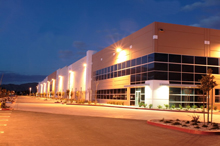Intelligent CCTV technology is fast becoming an indispensable resource when it comes to managers seeking to secure the health and safety of their workers on busy large-scale sites and also to deter unwanted intruders - in and out of hours - who, if left unchallenged, may find themselves in potentially hazardous and even life threatening situations.
The widespread application of surveillance technology, from network capable solutions to remotely monitored, detector-activated systems, is undoubtedly making a real difference on the ground in the day-to-day operations of commercial concerns ranging from large-scale waste processing facilities to motor dealerships.
A salutary tale regarding the need for event-driven CCTV in terms of minimising the risk of injury - and allowing help to be provided should it be required - comes from a motor dealership. In this case a customer, accidentally locked in at the close of business, scaled the perimeter fence and jumped down the other side, where there was a considerable drop - the end result was a broken leg for the customer and four and a half years of litigation for the business. Now with the addition of remotely monitored, detector activated, CCTV at least the business owner can be confident that this type of situation cannot be repeated, as operators at the Remote Video Response Centre (RVRC) would now be able to talk to the customer to reassure them and rapidly alert the keyholder to remedy the situation.
 |
| CCTV is indispensable in looking after the health and safety of workers and deterring intruders in and out of hours |
Another good example of the proactive use of surveillance for health and safety comes from a utility company. In addition to protecting critical assets such as dams and treatment plants, the CCTV system provides an extra level of safety. Specifically, one worker can remotely monitor the activities of another worker in the, potentially, dangerous chlorine storage room of a water treatment plant. In the event that a worker is overcome by fumes, help can be readily provided.
Turning to a waste recycling facility, here remotely monitored, detector-activated CCTV, has successfully, deterred young children from running around and using the site as a playground when it is shut down at night or during at the weekend. The concern for the manager in this instance, which led to the use of CCTV, was that although his own employees were well trained to deal with the waste on site, and the heavy equipment, it is certainly not a safe or appropriate environment for children.
CCTV's role in minimising risk, especially out of hours, was also reinforced recently on another waste site where, prior to the installation of remotely monitored CCTV, a vagrant would regularly come on at night to sift through the waste stored there. As with the previous example having someone wandering around unsupervised raised real safety concerns, especially given the split level nature of the site. The last thing the site manager wanted was to find an individual seriously injured or worse because they had an accident, now at least he can rest easy, safe in the knowledge that this eventually has been addressed.
The upshot of all this is that enterprises who are concerned about health and safety should seriously consider how intelligent CCTV can be applied to mitigate the potential risks they face.


















